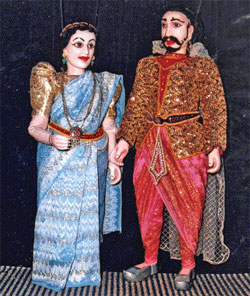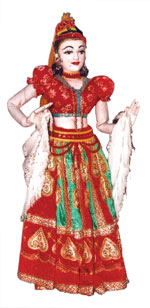Puppet tells a story
Sri Lankan threads local folktales with Indonesian
puppetry:
Rikaza HASSAN
|

The puppets are operated using the two rods affixed to their
hands |
With her talent and hard work, a young Sri Lankan lady is trying to
tell the island's folktales with Indonesian puppetry Wayang Golek that
involves intricately carved three dimensional wooden rod puppets.
Wayang Golek evolved from shadow puppets that originally came to
Indonesia from India. The puppets are operated using the two rods
affixed to their hands and a movable wooden torso. This allows them a
wide range of motion - they can be rotated as well as be moved up and
down. In the hands of an experienced puppeteer, they are almost
completely human like in their gestures and movements.
Dalang (puppet maestro) Asep Sunandar Sunarya is one of the foremost
puppet masters in modern times and is nicknamed Superstar Dalang due to
the international fame he has garnered for Wayang Golek.
In Indonesia full length Wayang Golek shows usually last six hours
and are performed for the public or on invitation for corporate or
personal events like the opening of a building or a wedding. The most
popular puppet stories are adapted from
|

The most popular puppet stories are adapted from classic Indian
ones |
classic Indian ones, containing all the elements of a classic
Bollywood film - love, hate, anger, violence, surprise and intrigue. So
perhaps it is not at all surprising that Dalang Sunarya took it all in
stride when a Sri Lankan girl turned up at his doorstep and asked to
stay for two months and learn his art. He agreed.
The girl named Sulochana Dissanayake first encountered three
dimensional wooden puppets in her 'Musics of South East Asia' class at
Bates College in the United States when her teacher Gina Fatone brought
out such a puppet.
"I was instantly attracted to the form," said Dissanayake.
"My mind blanked for the rest of the class as I focused on the
intricacy of this puppet - the minute detail on its face, the way it
'breathed' like a human and turned its head to gaze serenely at a group
of awestruck students. Then and there I decided to see the creation of
these puppets and how they 'lived' in modern times," Dissanayake wrote
later.
Xinhua |



